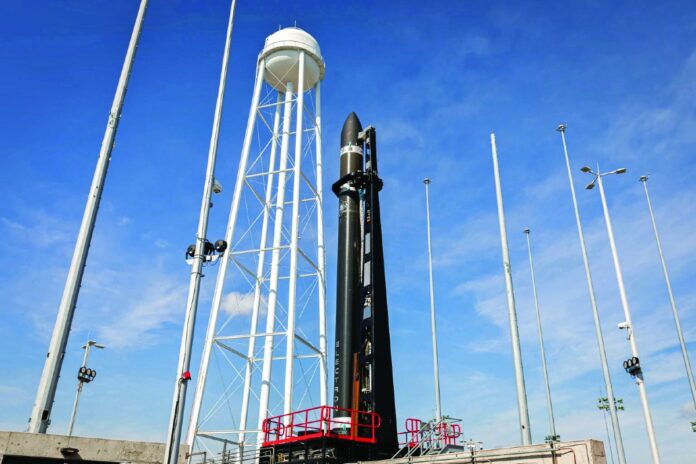When it comes to the Southern California space-launch industry, the 800-pound gorilla is Space Exploration Technologies Inc., or SpaceX, based in Hawthorne.
But in nearby Long Beach there is another company that is making strides toward its goal of reaching 15 missions this year – Rocket Lab USA Inc.
The company’s most recent mission launched its Electron rocket carrying a satellite payload from its facility in New Zealand.
The “Baby Come Back” mission, carried out on July 18, was Rocket Lab’s seventh launch of the year and the company’s 39th Electron launch overall. By comparison, SpaceX has carried out 57 launches so far this year and plans to launch 83 rockets by Dec. 31.
In addition to delivering a primary mission of deploying customer satellites to orbit, Rocket Lab completed a successful ocean splashdown and recovery of Electron’s first stage as part of the company’s program to make Electron the world’s first reusable small rocket.
SpaceX is also larger than Rocket Lab in terms of employees – 12,000 as of April of last year – compared to 1,400 for Rocket Lab.
Founded in 2002 by billionaire Elon Musk, SpaceX has been a pioneer in the space industry. The Hawthorne company has handled 88% of customer flights from American launch sites in the first six months of this year, according to launch data compiled by Jonathan McDowell, an astrophysicist who tracks space activity.
Rocket Lab had a mission launch scheduled for July 28 that was aborted during the ignition sequence. “We Love the Nightlife” was planned to be the first of four dedicated launches on Electron for Capella Space to deploy its next-generation Earth-imaging satellites called Acadia, Rocket Lab said.
Adam Spice, the chief financial officer of Rocket Lab, said that the company’s goal was to be doing two launches a month by the end of next year.
With three launch pads – two in New Zealand and one in Virginia – the company has the ability to launch rather quickly, Spice said.
End-to-end company
According to Spice, Rocket Lab always had a vision of being an end-to-end space company, one that could take their customers’ ideas and get them into space.
After having established itself as a leading provider of small satellite launches, the next step for the company to achieve its vision was to pick up the key pieces of being able to deliver a whole program, he added.
It did this by developing in-house space systems, meaning satellites and applications, and then doing a series of acquisitions, Spice said.
The first was in 2020, when Rocket Lab bought Toronto-based Sinclair Interplanetary, which develops spacecraft hardware, including reaction wheels and star trackers. Terms of the deal were not disclosed.
Then in late 2021 came the acquisitions of Advanced Solutions Inc., in Denver, an aerospace engineering firm that provides space software, including guidance, navigation and control products, for $40 million; and Planetary Systems Corp., a Maryland-based spacecraft separation systems company, for more than $42 million in cash and stock.
Finally, early last year, there was the acquisition of SolAero Technologies out of Albuquerque, New Mexico, which makes solar panels and other power-related systems for satellites, for $80 million in cash.
Setting itself apart
What makes Rocket Lab different from other large aerospace companies – including SpaceX, Northrop Grumman Corp. and United Launch Alliance LLC – that have become project manager and integrators is its ability to design, build, launch and operate satellites for its customers, Spice said.
John Holst, a former Air Force officer who now publishes the Ill-Defined Space newsletter, said that Rocket Lab does not compete with SpaceX.
There are significant differences between the two in terms of capabilities, with SpaceX’s Falcon 9 rocket able to lift more than 48,500 pounds of material to low-Earth orbit, while Rocket Lab’s Electron can lift only 660 pounds.
“The Falcon 9 is reusable, and Rocket Lab is attempting reusability with the Electron, but appears to be still experimenting with that concept,” Holst said.

And finally, the Electron costs customers more per pound – about $25,000 per pound for the full 660-pound capability, he said, adding this is where this is some overlap with the Falcon 9, as SpaceX does offer its Smallsat Rideshare Program for very little cost – $5,500 per pound.
“So, it may be that SpaceX poaches some of Rocket Lab’s customers on price,” Holst said.
Alex King, founder of Cestrian Capital Research Inc., an investment firm in the aerospace and tech industries in Newport Beach, said the customers that Rocket Lab goes after are different from those of SpaceX.
“So in that regard it probably doesn’t view SpaceX as a direct competitor,” King said.
Rather than competitive pressure, he believed the single most important hurdle to Rocket Lab achieving its goals is an adequate supply of capital.
Reusable rockets
Spice said that while he gave SpaceX credit for being “the ones who pioneered reusable launch vehicles,” the company does not have a monopoly on the reusability of rockets.
Rocket Lab is also using reusable rockets, as evidenced by the July 18 launch of the “Baby Come Back” mission.
Around 8½ minutes after liftoff, the first stage of the rocket deployed a main parachute to slow its descent, enabling a soft splashdown in the Pacific Ocean. From there, Rocket Lab’s recovery team brought the stage onto a vessel using a specially designed capture cradle, the company said.
The stage is now back at Rocket Lab’s production complex for analysis to inform future recovery missions and eventually re-flight of an Electron, the company added.
“We are well on our trajectory to establishing that capability as well,” Spice said.
The company is currently developing a new rocket – the Neutron – to be a competitor to SpaceX’s Falcon 9. It is capable of carrying 14 tons of payload into orbit and is designed from the ground up as a reusable platform.

